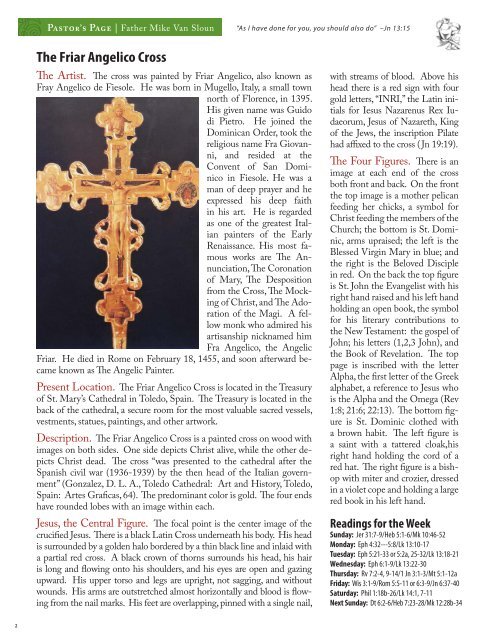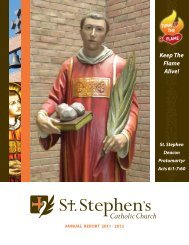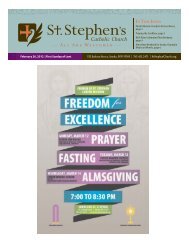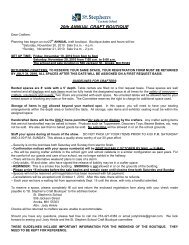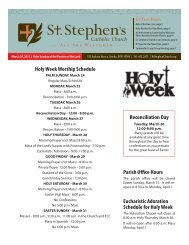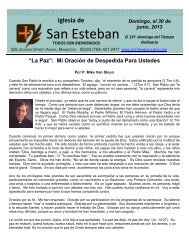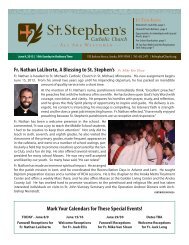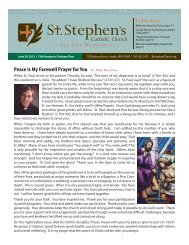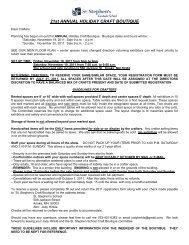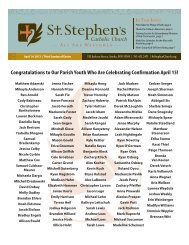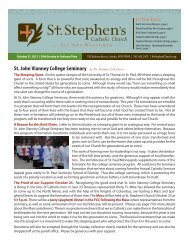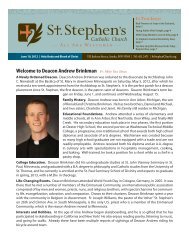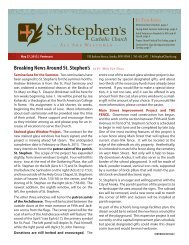All Souls All Saints In Memory - Church of St. Stephen
All Souls All Saints In Memory - Church of St. Stephen
All Souls All Saints In Memory - Church of St. Stephen
Create successful ePaper yourself
Turn your PDF publications into a flip-book with our unique Google optimized e-Paper software.
2<br />
Pastor’s Page | Father Mike Van Sloun “As I have done for you, you should also do” –Jn 13:15<br />
The Friar Angelico Cross<br />
Th e Artist. Th e cross was painted by Friar Angelico, also known as<br />
Fray Angelico de Fiesole. He was born in Mugello, Italy, a small town<br />
north <strong>of</strong> Florence, in 1395.<br />
His given name was Guido<br />
di Pietro. He joined the<br />
Dominican Order, took the<br />
religious name Fra Giovanni,<br />
and resided at the<br />
Convent <strong>of</strong> San Dominico<br />
in Fiesole. He was a<br />
man <strong>of</strong> deep prayer and he<br />
expressed his deep faith<br />
in his art. He is regarded<br />
as one <strong>of</strong> the greatest Italian<br />
painters <strong>of</strong> the Early<br />
Renaissance. His most famous<br />
works are Th e Annunciation,<br />
Th e Coronation<br />
<strong>of</strong> Mary, Th e Desposition<br />
from the Cross, Th e Mocking<br />
<strong>of</strong> Christ, and Th e Adoration<br />
<strong>of</strong> the Magi. A fellow<br />
monk who admired his<br />
artisanship nicknamed him<br />
Fra Angelico, the Angelic<br />
Friar. He died in Rome on February 18, 1455, and soon afterward became<br />
known as Th e Angelic Painter.<br />
Present Location. Th e Friar Angelico Cross is located in the Treasury<br />
<strong>of</strong> <strong>St</strong>. Mary’s Cathedral in Toledo, Spain. Th e Treasury is located in the<br />
back <strong>of</strong> the cathedral, a secure room for the most valuable sacred vessels,<br />
vestments, statues, paintings, and other artwork.<br />
Description. Th e Friar Angelico Cross is a painted cross on wood with<br />
images on both sides. One side depicts Christ alive, while the other depicts<br />
Christ dead. Th e cross “was presented to the cathedral after the<br />
Spanish civil war (1936-1939) by the then head <strong>of</strong> the Italian government”<br />
(Gonzalez, D. L. A., Toledo Cathedral: Art and History, Toledo,<br />
Spain: Artes Grafi cas, 64). Th e predominant color is gold. Th e four ends<br />
have rounded lobes with an image within each.<br />
Jesus, the Central Figure. Th e focal point is the center image <strong>of</strong> the<br />
crucifi ed Jesus. Th ere is a black Latin Cross underneath his body. His head<br />
is surrounded by a golden halo bordered by a thin black line and inlaid with<br />
a partial red cross. A black crown <strong>of</strong> thorns surrounds his head, his hair<br />
is long and fl owing onto his shoulders, and his eyes are open and gazing<br />
upward. His upper torso and legs are upright, not sagging, and without<br />
wounds. His arms are outstretched almost horizontally and blood is fl owing<br />
from the nail marks. His feet are overlapping, pinned with a single nail,<br />
with streams <strong>of</strong> blood. Above his<br />
head there is a red sign with four<br />
gold letters, “INRI,” the Latin initials<br />
for Iesus Nazarenus Rex Iudaeorum,<br />
Jesus <strong>of</strong> Nazareth, King<br />
<strong>of</strong> the Jews, the inscription Pilate<br />
had affi xed to the cross (Jn 19:19).<br />
Th e Four Figures. Th ere is an<br />
image at each end <strong>of</strong> the cross<br />
both front and back. On the front<br />
the top image is a mother pelican<br />
feeding her chicks, a symbol for<br />
Christ feeding the members <strong>of</strong> the<br />
<strong>Church</strong>; the bottom is <strong>St</strong>. Dominic,<br />
arms upraised; the left is the<br />
Blessed Virgin Mary in blue; and<br />
the right is the Beloved Disciple<br />
in red. On the back the top fi gure<br />
is <strong>St</strong>. John the Evangelist with his<br />
right hand raised and his left hand<br />
holding an open book, the symbol<br />
for his literary contributions to<br />
the New Testament: the gospel <strong>of</strong><br />
John; his letters (1,2,3 John), and<br />
the Book <strong>of</strong> Revelation. Th e top<br />
page is inscribed with the letter<br />
Alpha, the fi rst letter <strong>of</strong> the Greek<br />
alphabet, a reference to Jesus who<br />
is the Alpha and the Omega (Rev<br />
1:8; 21:6; 22:13). Th e bottom fi gure<br />
is <strong>St</strong>. Dominic clothed with<br />
a brown habit. Th e left fi gure is<br />
a saint with a tattered cloak,his<br />
right hand holding the cord <strong>of</strong> a<br />
red hat. Th e right fi gure is a bishop<br />
with miter and crozier, dressed<br />
in a violet cope and holding a large<br />
red book in his left hand.<br />
Readings for the Week<br />
Sunday: Jer 31:7-9/Heb 5:1-6/Mk 10:46-52<br />
Monday: Eph 4:32---5:8/Lk 13:10-17<br />
Tuesday: Eph 5:21-33 or 5:2a, 25-32/Lk 13:18-21<br />
Wednesday: Eph 6:1-9/Lk 13:22-30<br />
Thursday: Rv 7:2-4, 9-14/1 Jn 3:1-3/Mt 5:1-12a<br />
Friday: Wis 3:1-9/Rom 5:5-11 or 6:3-9/Jn 6:37-40<br />
Saturday: Phil 1:18b-26/Lk 14:1, 7-11<br />
Next Sunday: Dt 6:2-6/Heb 7:23-28/Mk 12:28b-34


